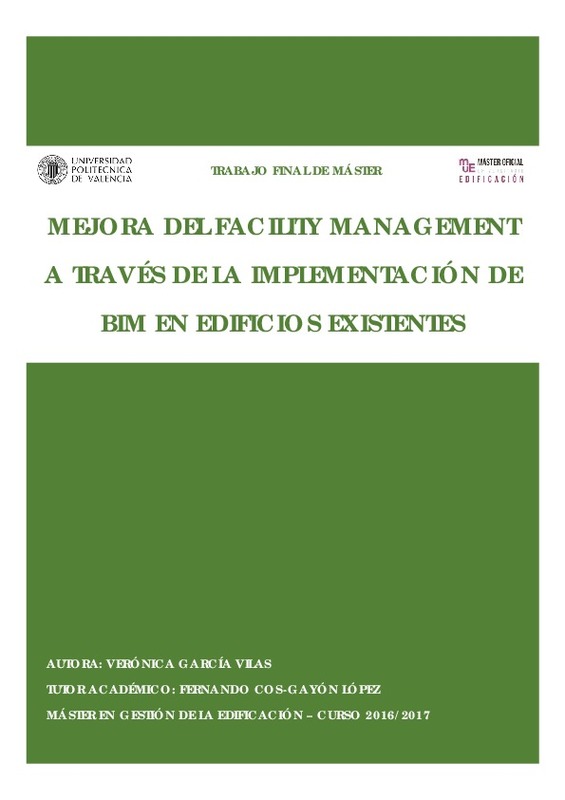|
Resumen:
|
[ES] Al pasar el tiempo, el valor de un edificio comienza a depender de su habilidad de funcionar de la manera más eficiente posible, al menor coste posible. Facility Management (FM) requiere de una gran cantidad de ...[+]
[ES] Al pasar el tiempo, el valor de un edificio comienza a depender de su habilidad de funcionar de la manera más eficiente posible, al menor coste posible. Facility Management (FM) requiere de una gran cantidad de información que proviene de varias fuentes y que debe ser procesada en poco tiempo. Por lo tanto, parecería lógico aplicar la metodología BIM al FM. De hecho, es cada vez más común que los proyectos tengan un modelo BIM a usarse desde la idea inicial y durante todo el ciclo de vida del edificio. Sin embargo, se habla poco de qué sucede con los edificios ya existentes. Debido a ideas como la dificultad de hacer modelos BIM para edificios ya construidos, la posibilidad de combinar BIM y FM con el objetivo de mejorar procesos existentes se ha explorado muy poco. Esto implica desperdiciar una oportunidad enorme, ya que la gran mayoría de los edificios de cualquier ciudad, al ser de una época anterior a BIM, entran en esta categoría. En Montevideo, Uruguay, por ejemplo, se venden anualmente entre 15000 y 20000 de las 500000 viviendas totales. De estas, casi el 70% fueron construidas entre 1950 y el año 2000. Todos estos edificios requieren de la gestión de sus operaciones diarias, de una forma óptima, que asegure confort y una buena rentabilidad. Por lo tanto, la aplicación de BIM significa una nueva oportunidad de negocios. Además, es de interés urbanístico, ya que la información ayudaría a conocer la situación real de cualquier ciudad. El objetivo de este trabajo es determinar formas en que se puede usar BIM para mejorar el FM de este tipo de edificios, determinar los beneficios y analizar los posibles desafíos. En este trabajo se hará uso del Revit, ya que es el software más usado en lo referente a BIM.
[-]
[EN] As time goes on, a building’s value depends on its ability to function as efficiently as possible, with costs as low as possible. Facility Management (FM) requires a great deal of information from multiple sources, ...[+]
[EN] As time goes on, a building’s value depends on its ability to function as efficiently as possible, with costs as low as possible. Facility Management (FM) requires a great deal of information from multiple sources, all of which has to be processed in a short amount of time. Therefore, it would seem logical to apply the BIM methodology to FM. It is, in fact, increasingly common for projects to have a BIM model to be used from the initial idea and throughout the lifecycle of the building. However, very little is said about what happens with existing buildings. Due to ideas such as the difficulty of making a BIM model for existing buildings, very little has been explored on the possibility of combining BIM and FM with the aim of improving pre-existing processes. As the great majority of any city’s buildings have no connection with BIM but have daily operations to take care of, it would seem important to find a way to apply the BIM methodology so as to improve what already exists. This means wasting an opportunity, as the great majority of any city’s buildings, which are from a time before BIM, belong to that category. In Montevideo, Uruguay, for example, between 15000 to 20000 out of the cities’ 500000 dwellings are sold each year. Almost 70% of those were built between 1950 and 2000. As the great majority of any city’s buildings have no connection with BIM but have daily operations to take care of, it would seem important to find a way to apply the BIM methodology so as to improve what already exists. All these buildings have daily operations that must be taken care of in a way that ensures comfort and a good profitability. Therefore, applying BIM would mean a new business opportunity. Besides, it is of urban interest, as the data would help know the real situation of any city. The aim of this paper is to determine the ways in which BIM can be used to improve FM for such buildings, determine the benefits and analyse the possible challenges. This paper will use Revit, as it is the most commonly used software in regards to BIM.
[-]
|







